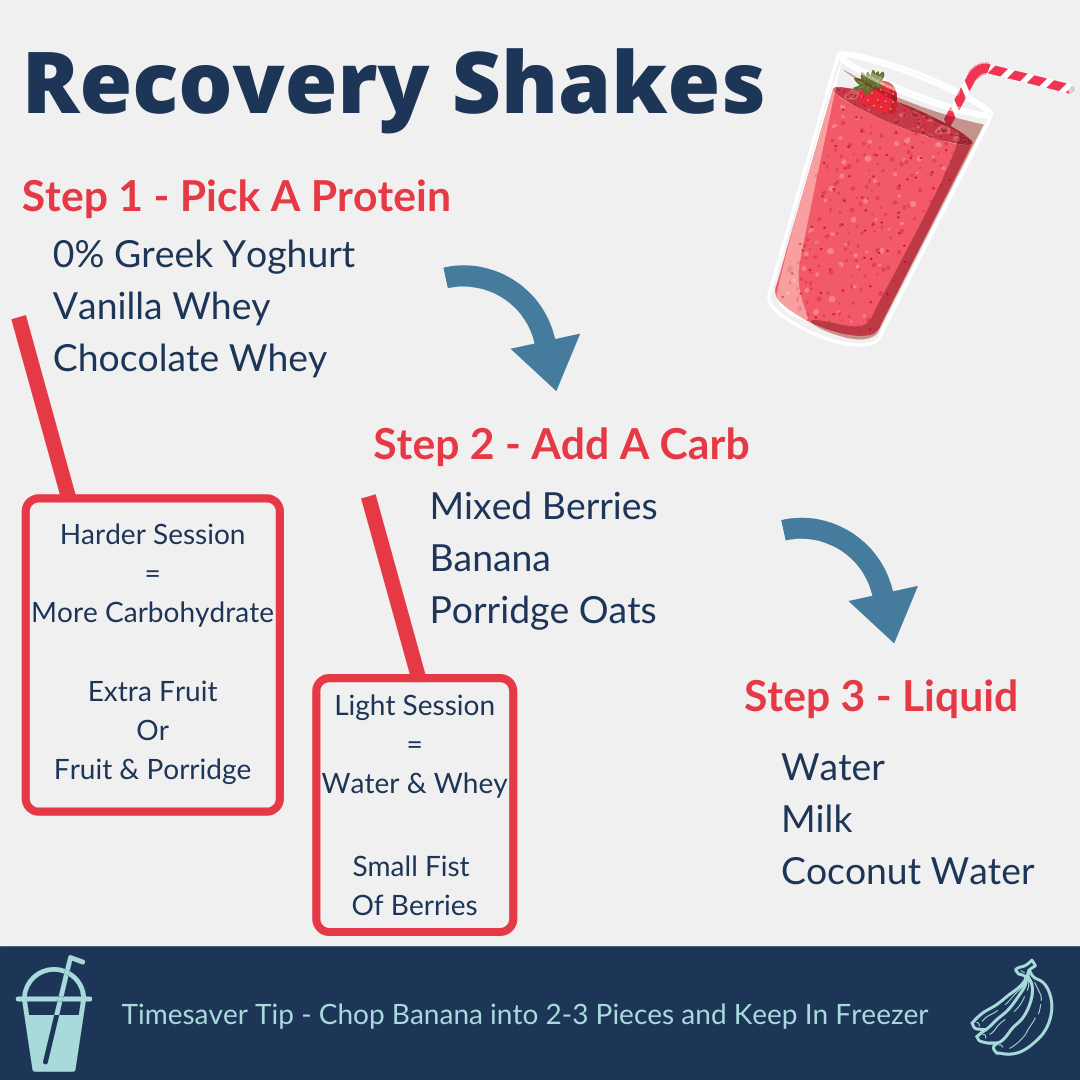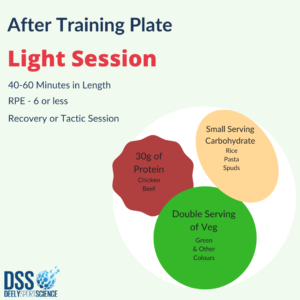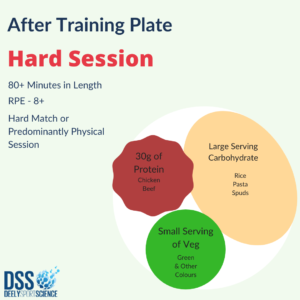
26 Nov Post Exercise Recovery Nutrition by John Murphy PhD(c)
Post-Exercise Recovery
~ by John Murphy PhD(c)
The last piece focused on fuelling adequately before games, particularly in the preceding 24-36 hours, and today we’re going to focus on the period after games or training and how to maximise recovery.
This will be broken into two sections; the first focuses on immediate recover, or directly after games/training and the second section focuses on the few hours afterwards.
Part A – Immediate Recovery
The post-workout window or ‘Window of Gainz’ is often spoken of among gym-goers. Most feel that they must consume a portion of protein (generally a double serving of whey) within 20 minutes of completing their gym session. However, it’s rare to see people act the same after a training session or game even though it may have been of much higher intensity and used up a considerably larger amount of energy (calories).
There are two main types of physical recovery required within the muscle after intense exercise. When we go perform resistance exercise (weight training, etc,), it causes a number of tiny tears in the muscle. These heal over the course of 24-48 hours. Each time they heal, they grow a little stronger. This is why we get progressively stronger over time from lifting weights, provided there is adequate recovery time between sessions. Protein is the main macronutrient required for repairing these tiny tears and most feel it is necessary to consume protein immediately after exercise. Due to a number of studies by Brad Schoenfoeld, Stu Phillips, Kevin Tipton and countless others, we now know that protein should be evenly spaced out across the day as it takes so long to be fully digested and used by the muscles. While we’ve discussed protein in more detail previously, for now we just need to know that protein immediately after exercise is not a necessity for exercise, however we most likely have gone 3-4 hours since previously eating a portion so are most likely due a portion of protein anyway.
The other type of recovery required involves replacing the energy stored within the muscle, known as glycogen. Glycogen is supplied to our muscles from digested carbohydrates. Glycogen can be topped up relatively quickly, especially in comparison to protein, so consuming carbohydrate immediately after exercise becomes of much greater importance than consuming protein.
The type of carbohydrate has a significant impact on how quickly it is absorbed by muscles. Wholegrain carbohydrate sources, which are typically higher in fibre, will be released to working muscles much slower than other sources that are typically higher in sugar. These high-fibre, wholegrain sources are ideal for fuelling general day-to-day activities and slowly releasing energy throughout the day, but will not quickly replace lost glycogen stores after intense exercise.
Fast-acting carbs are the best way of replacing glycogen after intense exercise. These generally come from carbohydrates that are higher in sugar and lower in fibre, although fruits are a good option despite the presence of fibre. Convenience is also a key factor when picking carbohydrates for directly after exercise. Freshness and taste in the dressing-room, directly after a game or training session must be taken into account when picking foods for immediate recovery. While a fat-free, fruit-flavoured yogurt may provide the right blend of nutrients after a game, it can be difficult to eat if you’ve forgotten your spoon or it’s covered in dirt from a mucky pitch.
Recovery Options:
- Flavoured milks are excellent sources of post-exercise nutrition as they combine a blend of high-quality protein with fast-acting carbohydrates in an easy to carry container.
- Many supplement companies now produce recovery blends of carbohydrate and protein mixed together in one formula.
- Fruit (bananas, apples, berries, etc.,) with yogurt drinks (Yop).
- Smoothie Blends (see figure 1)
Smoothies are a tasty and nutritious way to meet the requirements of post-workout recovery. Athletes can combine a number of different flavours to meet their own preferences. My own particular favourite is to mix frozen raspberries, vanilla protein, water, ice and spinach. Mixing spinach and raspberries turn the smoothie brown but still taste unbelievable!!
The amount of carbohydrate consumed after exercise is dependent on the intensity and duration of exercise, timing of the next bout of exercise and the size of the athlete.
Part B – Post Game-Training Meals
Very intense and/or long sessions will use up large amounts of glycogen. Replacing this glycogen requires careful planning in terms of how much carbohydrate is consumed afterwards. How to define the intensity of a session can be difficult for many people and often leads to us consuming either too much or too little carbohydrate (or food in general). Using a combination of time and RPE can help us in deciding on our carbohydrate requirements after exercise. We generally recommend the following in terms of how to rate the intensity of a training or match.
*RPE – Rating of Perceived Exertion
1-10 scale of how difficult a session was. 10 is the hardest session you have ever experienced. 1 is lying in bed relaxing.
The snacks mentioned above are ideal to keep in a gear-bag for directly after training but ideally we would consume a more traditional looking meal within an hour of our snack. This meal should include a serving of lean protein such as chicken, turkey, beef, tuna, cod, etc., We should avoid fats at this stage as they will slow down the absorption of nutrients. It is important to note that many accompanying sauces or gravy may contain fat so should be avoided or replaced with low-fat options in the post-exercise meal. Choosing the amount of carbohydrate to be consumed is key at this meal. The length or difficulty of the session will guide the serving of carbohydrate. A light session usually requires a small serving of carbohydrate. A medium session requires a moderate serving of carbohydrate. A hard session requires a large session of carbohydrate. Complex carbohydrates, such as rice, potatoes, quinoa, cous-cous or pasta, are best here and should be adapted to suit your own preferences.
Using a variety of vegetables to fill your plate (and stomach) will help you feel full and satiated after lighter sessions. Adjusting the amount of vegetable consumed should be dependent on the intensity of the session and the amount of carbohydrate consumed. If you have just completed a long and intense session, and require a lot of carbohydrate to recover then extra vegetables will take up a lot of space in your stomach.
A key tip for the post-recovery meal is to have something that can be eaten with a spoon. It allows players to consume much quicker and breaks down the barrier of cutting up meat when appetites may be low due to fatigue from the game.
If organising meals with a. caterer for a group then I recommend you ask them to separate the protein and carbohydrate sources, into separate bowls and let players determine their own portion size of each. It’s also worth having a large salad bowl there for any players with lower calorie needs – such as those who are injured, goalies, or unused subs. If it’s after a training session then highlight any players on a weight management programme to the caterer/server so they know not to give too large a portion.
If you want further information on anything said here then feel free to contact me (John) at [email protected].
You can find my profile on The Twitter Machine or The Gram for more recipes and nutrition info.








No Comments